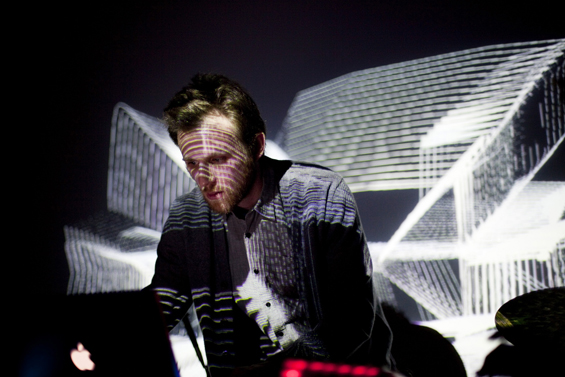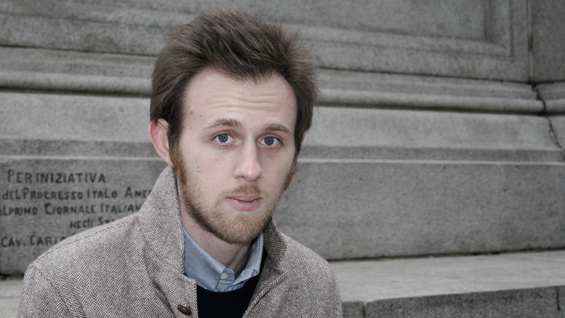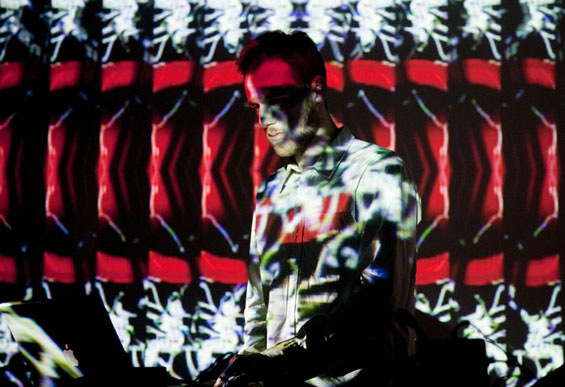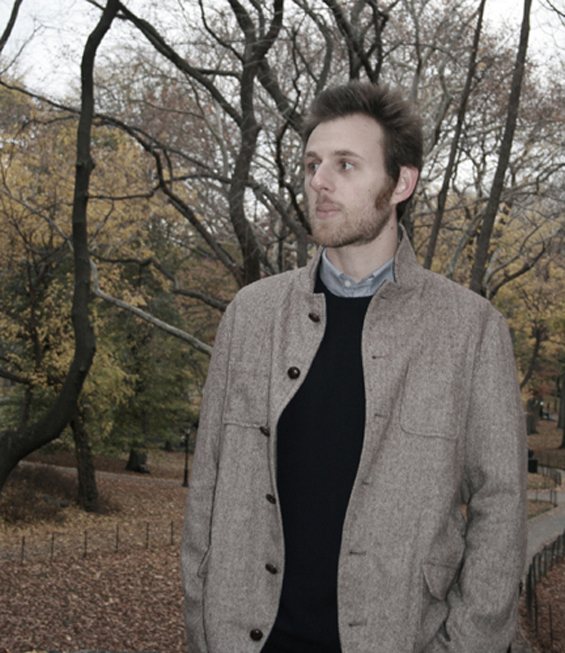

TEN QUESTIONS WITH EZEKIEL HONIG
New York City native Ezekiel Honig has graced our pages a number of times before, whether it be as the focus of a general profile or as a participant in a listening post. This marks the first time he's appeared in a formal textura interview, however, and there's no better time for that to occur than right now, given the imminent release of his latest collection, Folding In On Itself. With his previous solo album, Surfaces of a Broken Marching Band, having appeared more than two years ago, one approaches the new release with anticipation and expectation, the thinking being that the time between the releases may have brought with them changes in his working methods and style. Be that as it may, the first question invariably addresses the fact that the new work appears on the UK-based Type label as opposed to Honig's own Anticipate.
1. The obvious first question concerns why the new album appears on Type rather on your own Anticipate.
Simply put, Type reaches a larger and different audience than Anticipate. Beyond that fact, I really welcomed the prospect of working with someone else, to have another company promote my work, but more importantly, a label which I respect and trust with it. Especially after doing the work of releasing a few albums on my labels, and understanding what goes in to that process and how it works, I'm pretty excited to take a step back. I have never felt completely comfortable with the self-promotion thing, though I've done plenty of it, as one has to, so I think that Type will do a better job of promoting my work than I could.
2. As it's been over two years since your last full-length, Surfaces of a Broken Marching Band, appeared, I'm curious to hear how you think the new collection, Folding In On Itself, differs from it and how your approach has changed (if it has) since your work on the previous release.
I'm always working with a sense of a continuum, of wanting to move along so that a new piece of work connects to the previous one but clearly goes somewhere else. In this case, I would say that the two albums have a lot in common, but Folding In On Itself uses field recordings as an instrument in their own right in a more pointed manner. I think it has some more subtlety perhaps, is more staid in its funneling of its ideas, in the nature that the sounds were edited and arranged. I think it has a greater sense of building a scene in each track, more of a sense of place. I think this was just a natural extension of where I was going. Ideas like this are overt and on purpose, but there are also more suggestive emotional nuances which come through based on where I was in that two-year period versus the production process of the previous record. It was definitely a transition period in a number of ways on a personal level, which lends itself to questioning everything, including whether to make a record or not. I always feel that it's good to take nothing for granted, including one's own passions, and once they're re-confirmed you come out stronger on the other side.
3. Without wanting to turn the interview into something too gear-oriented, I'm nevertheless curious as to whether there were any significant changes in the technology and/or equipment that you used for the new release and that therefore figured into the new music being different from what you've produced before.
I approach the technology the same as I have in the past really, which is to use the bare minimum of what I need to get the results I'm looking for. I use a portable digital recorder, an external mic if needed, a Mac Powerbook, Logic as my main sequencer and mixdown environment, and Ableton Live where needed as a tool in the process. For me, the parts that matter are the sounds recorded and how I edit and process them. Really, more and more I'm finding that it's all about editing for me, which comes down to my own process more than the gear I use.

4. Could you enlighten us with respect to the actual production process you used in creating some of the album's tracks by taking us through the steps that were involved in bringing them into being?
My process isn't super-systematic so my answer will inherently tell a portion of the story (please take it with a grain of salt). I usually start with either an instrument sound I want to write something with or by recording some objects or taking a walk, and seeing what sounds happen, what I can take out of this that could be useful. I am usually inspired by a sound that I capture rather than an idea that comes out of thin air.
I then begin to experiment with textures and melodic tones and just play with short arrangements until they build up and become something which feels significant, which I can begin to see how it would turn into a complete piece. It's about making fragments which begin to take the shape of a whole over time. I say experiment because I have a better idea of what I want to hear when I hear it, but don't always know how to get there. If I sound like myself then it's because that's what I naturally want things to sound like, but it usually happens through that route rather than a conscious sense of needing to sound like the last track I made. I purposely leave the originating idea vague in order to be looking for the new inspiration that comes out of certain combinations of sounds, timbres, and harmonics. I'm looking for the unexpected, so a giant part of this is learning how to recognize what I want to hear when it happens and how to coax that towards completion.
It can be a slow, frustrating process sometimes because I need to work through a bunch of nonsense in order to find what I'm looking for. Maybe it's just how I work, or maybe it's because I don't have composition instruction in my background, but I generally have to meander a bit in order to arrive where I want, and sometimes the goal is foggy until it's happening.
5. Can you use a particular piece from the new album to illustrate what you're getting at?
As an example, the track “Between Bridges” germinated from a sound I edited out of a recording of tapping out rhythms on my wood desk. There was one random knock which just felt like it needed to be a hook in a rhythm and it became the center of the track, with a vocal sample, bridge sounds, and Rhodes falling in around it. That one knocking sound is what the track revolves around, though. I remember it very distinctly because it was as if the edges of it defined all of what would happen around it, but the rest had to be filled in for it to make sense. To be fair, once I got into it, it went into a different emotional place and wasn't planned out, but that percussion sound definitely led to the rest of the rhythm and feel.
That is maybe a good indication of some of my motivation, to build material around a single sound because it communicates something that I want to put forth, but I also want it to be palatable to someone besides me listening to a loop in my studio. This music is extremely personal, but I also want others to listen to it.
6. My impression of the new album is that the textural dimension of your music is emphasized more than ever before and that there's a tendency to leave the field recording elements in a more intact form rather than use them as source material for accents to be integrated into a song. Does that strike you as an accurate impression or is your own take different?
That's pretty much spot on. I never leave anything intact, as there is a lot of editing happening with the recordings, and that is a major theme in the album—the editing together of a new version of experiences, a new version of a city from recordings of actual experiences within that city.
I wanted to let those types of textures play a larger role in this album, to let field recordings act as the instruments they can be, to let them play more of a foreground role than I have in the past. It's a balance, because I want the songs to be more than the sound of a city, but on at least some of the tracks (e.g., “Folding Us In On Itself,” “Ancestry Revisiting Each Other”) I had a more palpable sense of the urban environment and instruments playing together to form a scene, a setting where they could co-exist in the same space, weaving in and out of themselves instead of one taking the clear lead throughout.
I wanted the whole album to have a greater sense of place, because the places essentially acted as both themes in and of themselves and the frame for other themes of experience, recontextualizing memory and thinking about whether truth matters as much as an edited version of that truth which you carry around with you. In your mind you have an edit of an experience, or rather, an edit of an emotion associated with it, but your edited memory is what you carry around with you and that affects your new behaviour, thoughts, experiences so it becomes what matters in a real day-to-day sort of way.

7. I also hear a more confident usage of traditional instrumentation in a few of the songs. Has the balance between traditional instruments, field recordings, and sampled found-sounds undergone a shift as your music has developed?
The balance has definitely shifted here and there. On the last album I specifically wanted to incorporate some new instruments and restrict the use of Rhodes, which had become a staple for me. Before that I was concerned only with the feel of the melodic material and not with where it came from. Similarly, I had been less concerned with bringing in recordings of outside into the process and concentrated predominantly on objects that were utilized in the home. Suddenly I felt more of a need to open everything up a bit, both literally and figuratively. On this record I cared a bit less about the variety of instruments, but nonetheless I used piano, trumpet, Rhodes, and guitar.
8. “High & Low,” for example, stands out for including a sound I've not heard before on your recordings, specifically something reminiscent of an e-bow guitar.
On “High & Low” I edited a couple phrases out of guitar playing that Mark Templeton sent me and pitched it and effected it to get that twangy sound that I was looking for. At the risk of repeating myself, I was approaching the field recording elements on an equal playing field as instruments in some tracks but still leaving them as background texture on others (e.g., “Drafting Foresight” ). I guess over time I've become more interested in using different instruments to add variety to the palette, but at the end of the day, it's all sound to be manipulated into something else. Ideally I would have a studio with tons of broken instruments that I could play badly and pull interesting sounds out of.
9. It's a challenge to keep a label running at any time but even more so today. What is the current status of your two labels, Anticipate and Microcosm, and what do you foresee for the their future?
I have gone back and forth in my head about whether to keep both labels going, and if so, to what extent. I'm not going to take up space here with a dissection of the industry and the changes it has gone through, and the changes it will go through, especially because no one really knows the ramifications.
I can't honestly say that I will keep both labels running indefinitely and running in a major way. I'm one person, and even on a small scale there are financial concerns, and aside from that, it takes time to run a label properly, and time is always in short supply. Please let me be clear that I'm not even relenting the state of the industry. It's just a fact of the matter. It all comes down to personal choices about which sacrifices you're willing to make and whether you can make them and sustain yourself.
This is a long-winded way of saying that I'm keeping the entities in existence, but only releasing something when the mood strikes and generally not looking for new artists or signing anything. There are a couple releases in the pipeline which I'm very excited about (a Bunnies + Bats twelve-inch with remixes and an offthesky CD/DVD project), and Anticipate will definitely remain as a platform I would like to use, but what that entails will change continuously away from a traditional music label structure.Wherever it goes, it will always be art-centered and sound art for the most part.
10. What other projects are in the works for you in the immediate future as far as recordings and live performances are concerned?
I have a couple of performances coming up in NYC and one in Los Angeles in July. For the most part I play shows when they come up but don't plan anything regularly. I get excited about performing in waves and then feel okay with stepping back from it for a bit. I think it's healthy and keeps it super interesting when the timing is right.
I have discussed a collaboration with Mark Templeton for some time and think we may move forward on that later this year. I also have this project where I asked people to submit a list of what sounds I should use to make a track and would like to begin working on those as soon as I get some time.
I'm going to focus more on a greater variety of projects, though, on music for film and dance and collaborations with visual artists. I want to spend more time on different approaches and not stay confined to anything specific for the moment. In a lot of ways I feel like this album is a culmination of something, and I think where I want it to go next is off the page as it were, across to a different medium. It's about stretching sound and finding new homes for it and new uses for it, so that's where I'm going to be concentrating for a while.

May 2011![]()